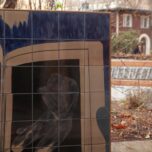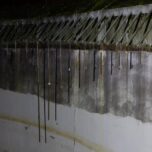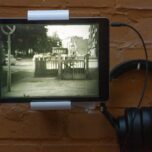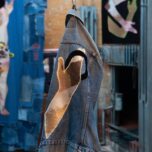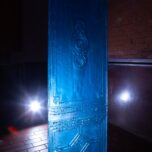Exhibition:
02/12/2021–20/02/2022
Opening:
02/12/2021, 5–9 pm
Exhibition and events curated by:
Malte Pieper, Lusin Reinsch
Events co-curated by:
Lara Huesmann, Annika Maus
“Into the drift and sway” is the 4th part of the annual programme “Bricolage”
Events
15/12/2021, 7 pm
Exhibition tour with the curators (in German language)
20/02/2022, 3 pm
Reading with Lucas Odahara and hn. lyonga
Performance postponed due to stormy weather – new date:
24/02/2022, 7 pm
A Side / B Side
Alizée Lenox and Els Vandeweyer play Lindsay Lawson’s Organum
Event details will be published online.
The group show “Into the drift and sway” considers the Bärenzwinger as a place in constant flux. Located at the southern entrance to Köllnischer Park, the Bärenzwinger was built on an area that formerly contained a street-cleaning depot with a public restroom run by Berlin’s city sanitation department from 1901 to 1938. The building of the former depot was converted into a bear pit using the bricks of the pre-existing architecture. What stories from the past reside in its walls, which new qualities appear from its cracks?
The proximity of a park, the nearby banks of the Spree river, a former public bathing house and records of 1920s homosexual venues in the bear pit’s neighbourhood on Wallstraße and Inselstraße suggest the site’s previous use as a cruising area. Public restrooms or urinals, such as those in Köllnischer Park, were already documented in Berlin around 1900 as anonymous meeting places for homosexuals in the book “Berlins Drittes Geschlecht” (Berlin’s Third Sex, published in 1904) by the doctor and sexologist Magnus Hirschfeld.
The possible queer history of the surrounding area has left traces which the exhibition’s site-specific artistic interventions pick up on. From 1920 onwards, the publisher Adolf Brand regularly gathered with the “Gemeinschaft der Eigenen” (Society of the Own-Willed), a homosexual men’s club, in the neighbouring Marinehaus, formerly a home base for the imperial navy. Brand was a difficult man: while advocating for the abolishment of paragraph 175 which deemed homosexual acts between men illegal, he was an anti-Semite, sympathized with the Nazis and was in favor of traditional gender roles, idealizing a virile masculinity. Ludwig Hoffman, architect of the street-cleaning depot and public utility building, also built the infamous Märchenbrunnen in Volkspark Friedrichshain – which later became one of the most popular gay cruising sites in former East Berlin. In GDR times, the Klappe (“cottage”/”tea-room” in German gay slang) at Märkisches Ufer is reported to have been a meeting place for gay men, in close proximity to the bear pit. One of the founding members of the Homosexuelle Interessengemeinschaft Berlin (HIB, a gay rights association in the GDR) worked as a bear keeper at the bear pit in the 1970s.
Drawing from these historical constellations the exhibition traces queer stories, gathering six contemporary artists who address masculinities and questions of cruising and gender, reflecting on and claiming space for desire in the private and public sphere. On display are installation works, drawings, sculptures and textile works that interact with the specific history of the Köllnischer Park and the current architecture of the Bärenzwinger.
The exhibition borrows its title from a short story by gay rights activist and artist David Wojnarowicz, recalling memories of cruising and anonymous intimate encounters in urban landscapes. These recollections are marked by ambivalences. Often a transformation is at play – public spaces, industrial buildings or abandoned locations are turned into spaces of pleasure or violence. Queer spaces are also contested spaces, disappearing due to surveillance measures, policing, gentrification, and changing ways of living a “queer” life.
Christa Joo Hyun D’Angelo
Christa Joo Hyun D’Angelo is an American artist based in Berlin. The core of D’Angelo’s work confronts fear, vulnerability, and what is thus invisible through video, neon, installation, and sculpture. Drawing on narratives that involve the legacies of colonialism, racism in Germany, HIV stigma specific to women of color, transracial adoption, and domestic violence, she navigates precarious conditions and attempts to redefine what is normal while embracing difference as a source of inspiration and empowerment in order to discover new means of acceptance and ultimately, healing..
She has exhibited at The Screen City Biennial, Arsenal Institute for Film and Video Art, Kunstraum Bethanien, Taiwan Digital Arts Center, and The Goethe Institute with upcoming exhibitions at Kunstmuseum Wolfsburg, Villa Merkel and SOMA Artspace. Her work has been reviewed in Artforum, Elephant Magazine, The New York Times, and GalleryTalk and is included in The Federal Collection of Contemporary Art Germany. D’Angelo has designed sets for Fever Ray and King Kong Magazine.
Constantin Hartenstein
Constantin Hartenstein is a German artist based in Berlin. He studied at University of the Arts Berlin and Braunschweig University of Art with Professor Candice Breitz. In 2011, he worked as a film producer for the German Pavilion at the Venice Art Biennale. Since 2019, Hartenstein is an Artistic Associate at the UdK Film Institute Berlin.
He received grants and prizes including Akademie der Künste, Stiftung Kunstfonds, Kunststiftung NRW, VISIO European Program on Artists’ Moving Images, Institut für Auslandsbeziehungen (Künstlerkontakte) and Karl Hofer Gesellschaft grant. Hartenstein participated in several artist in residency programs such as Triangle Arts Association New York, Calle Mayor 54, Grand Central Art Center Santa Ana, Flux Factory New York and Künstlerdorf Schöppingen. His works are included in public and private collections; and have been exhibited and screened at international institutions.
Recent exhibitions include Studio Berlin (Boros Collection/Berghain), Kunstverein Dresden, Staatliche Kunsthalle Baden-Baden, Galerie für Zeitgenössische Kunst Leipzig, Kunstraum Kreuzberg Bethanien Berlin, Galerie im Turm Berlin, Neuer Aachener Kunstverein, WRO Media Art Biennale Wroclaw, Berlinische Galerie, Anthology Film Archives New York, Goethe Institute Beijing, Spring/Break Art Fair New York, Museum of the Moving Image New York (USA), Times Museum Guangzhou (CN), Kunstmuseum Bonn, Bundeskunsthalle Bonn, German Consulate New York, Goethe Institute New York and transmediale Berlin.
Lindsay Lawson
Born in the United States and living in Berlin, Germany, Lindsay Lawson received her BFA in Sculpture from Virginia Commonwealth University, her MFA in New Genres from UCLA, and attended the Städelschule in Frankfurt am Main in the class of Judith Hopf. While working with a wide range of sculptural media including ceramics, fountains, lamps, and 3D printing, Lawson’s practice also encompasses film, video, and digital renders. Her practice often deals with the presence and agency of objecthood in virtual and physical spaces. Numerous bodies of work investigate states of infatuation with virtual personas and both virtual and physical objects.
Her work has been exhibited internationally at venues such as Efremidis Gallery, Berlin; Herald St., London; LAXART, Los Angeles; Yossi Milo Gallery, New York; Centre Pompidou, Paris; the 9thBerlin Biennale; Frutta Gallery, Rome; Kunstverein Leipzig; Piktogram, Warsaw; Trafo Contemporary Art Center, Budapest; and TEA Museum, Tenerife. Lawson will present a solo exhibition at Efremidis Gallery, Berlin in January 2022 including a new series of paintings as well as sculptures and a fountain installation.
Lotte Meret
Lotte Meret (*1985, Berlin / Germany) analyzes the effects of digital media on our identity. In her practice she articulates the influence of technologies and digital media on body experiences and body knowledge. In this context between physical experience, political agency and digital worlds – Lotte Meret creates new narrative formats and develops hybrid sculptures and installations. She was an artist-in-residence at the Van Eyck Academy in Maastricht and was included in the Emerging Artists Program from the German Short Film Association.
Her work has been presented at OCT_LOFT, Shenzhen; EIGEN+ART Gallery, Leipzig, NRW Forum, Düsseldorf; Goethe-Institut, Beijing; Kunsthal Rotterdam; Kunstverein Leipzig; Nottingham Contemporary; Kunstmuseum Bonn; Kunsthalle Basel; ZKM, Karlsruhe; Kunsthalle Baden-Baden. In collective structures she has published the publication ‘Body of Work’ and the record ‘Don’t DJ – Authentic Exoticism’. With the interdisciplinary label SEXES she is involved in installations and music events for clubs and festivals. Her works are included in international collections as the Lafayette Anticipation, Fonds de dotation Famille Moulin in Paris and Kunstkredit, Kanton Basel-Stadt.
Lucas Odahara
Lucas Odahara, born in São Paulo, lives and works in Berlin. Probing the complex relationships between body, space and memory, Odahara works in diverse media to create often architectural-scale installations in which personal and external visual and textual materials are invoked to recompose diverse scenes. Odahara reimagines the materials he encounters as open negotiations in a present that is never complete. In doing so, he often returns to the format of painted ceramic tiles. Employing a technique that has historically served in the depiction of colonial narratives, in his work, he welcomes the format’s modularity as a tool for re-imagination.
He holds a bachelor’s in product design from the São Paulo State University and a master’s in arts from the University of the Arts of Bremen. His work has been presented in numerous exhibitions in Europe as well as in South Africa and Pakistan. He is currently a recipient of the Kunstfonds Bonn work grant.
Emma Wolf-Haugh
Emma Wolf-Haugh is a visual artist, educator and writer based in Dublin and Berlin and working internationally. Emma’s work is shaped by economic necessity, engaging forms of recycling, thrift and ephemera that result in soft modularity, wild archiving, and performative intervention, posing questions about value, accumulation, and authorship. They sees a cultural centring of thrift as part of a tradition of queer-working class vernacular and ethics, promiscuous and adept at working within limitations. Their pedagogical and publishing work posits the imagination as a political tool with radical potential that can exist and erupt anywhere and at anytime. Their work is often collaborative generating forms of temporary collectivity, intent on the erotic and energetic capacity of brief encounter. Emma’s work occupies many different sites, spaces and relations including exhibition, performance, filmmaking, publishing, writing, disruptive pedagogy, friendship and solidarity, elements that often get messy together in long term projects.
Emma has developed a trilogy of works since 2014 dealing with sexuality and space. The Re-appropriation of Sensuality, Sex in Public, and Domestic Optimism have been exhibited through various iterations at: The Project Arts Centre Dublin, The Grazer Kunstverein Graz, NCAD Gallery Dublin, Dundee Contemporary Arts Dundee, District Berlin, Den Frie Center Of Contemporary Art Copenhagen, The Galway Arts Centre, nGbK Berlin, Scriptings Berlin, Archive Kabinet Berlin, Survival Kit Festival Riga among other places. Emma is co-founder of The Many Headed-Hydra (TMHH), aqueous-decolonising collective since 2015 working on long term critical and poly-vocal projects across the seas that connect Pakistan, Sri Lanka, Iceland, Germany, Ireland, Lithuania and beyond.
Rundgang
15/12/2021, 7 pm
Exhibition tour with the curators Malte Pieper and Lusin Reinsch
Language: German
On the evening of December 15, the curators of “Into the drift and sway” invite you to join a guided tour (in German language) of the exhibition and visit the show and research that it is based on together.
The 2G regulation is valid for the visit in the Bärenzwinger. Please bring the proof of vaccination or recovery with you.
We additionally ask you to please wear a mask while visiting the exhibition.
Reading
20/02/2022, 3 pm
Reading with Lucas Odahara and hn. lyonga
Event in English language. The texts will be available as print-outs as well.
2G+ regulation is valid for the visit in the Bärenzwinger. Please bring the proof of vaccination or recovery with you and a negative Antigen-test result (no older than 24 hrs), or a proof of third (“booster”) vaccination.
We kindly ask you to wear a mask while visiting the exhibition.
As part of Lucas Odahara’s Sleep and Death (Rasse & Schönheit), commissioned by Bärenzwinger Berlin for the exhibition „Into the drift and sway“, the artist prepared a collaborative exchange with writer hn. lyonga
set to take place on Sunday, February 20th at 15h.
In the past year, Odahara and lyonga have actively engaged in each other’s practices and personal lives. As queer people of color living in Germany for over a decade, their work often engages with questions of race and gender within European spaces and histories.
For the upcoming event, they are stepping aside – but not away from the convoluted history surrounding Adolf Brand, the founder of Germany’s first published gay magazine. Odahara’s installation places a fragment of this history in the water basins of the Bärenzwinger.
What are the water’s wills, motives, and modes of remembering? How can memories of the global south exist next to the monolithic power of western histories? Is it possible to look at water as a space of memory, in transition – one in which personal and historical memories can coexist? These questions are the bedrock upon which Odahara and lyonga’s collaboration rests. Their new texts ‘Twin Constellations’ and ’The river flows fastest towards the end’ will be read in public at the event.
Following the reading, a visit to the café of nearby Marinehaus is proposed.
a side / b Side
Postponed due to stormy weather – new date:
24/02/2022, 7 pm
A Side / B Side
Alizée Lenox and Els Vandeweyer play Lindsay Lawson’s Organum
A short concert in two acts divided by a pause for drinks and chatter
Musicians: Alizée Lenox and Els Vandeweyer
Lindsay Lawson’s Organum is a sculptural, architectural, and sound installation of over 200 wind chimes hanging from the security spikes on the perimeter moat encircling the Bärenzwinger. Divided in two halves, just like the grounds themselves, each side of Organum is tuned to eight octaves of a musical scale. Artist and musician Alizée Lenox will perform electric guitar while surrounded by and responding to the Organum.
Experimental vibraphonist Els Vandeweyer will apply an unconventional percussive technique to this watery and unwieldy instrument.
2G+ regulation is valid for the visit in the Bärenzwinger. Please bring the proof of vaccination or recovery with you and a negative Antigen-test result (no older than 24 hrs), or a proof of third (“booster”) vaccination.
We kindly ask you to wear a mask while visiting the exhibition.


